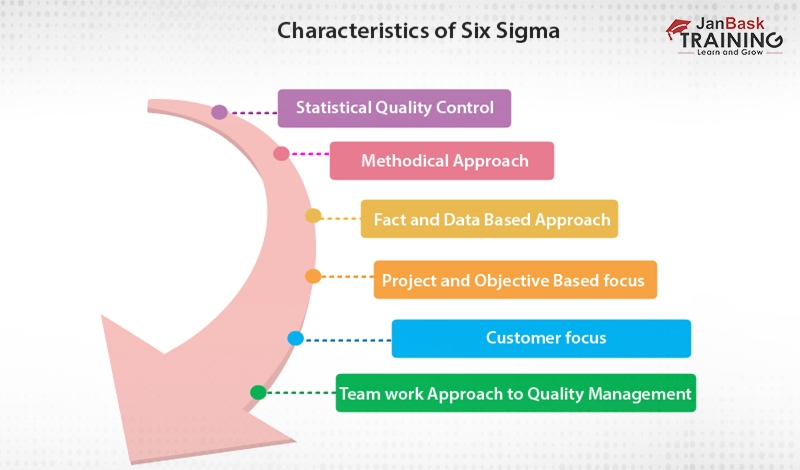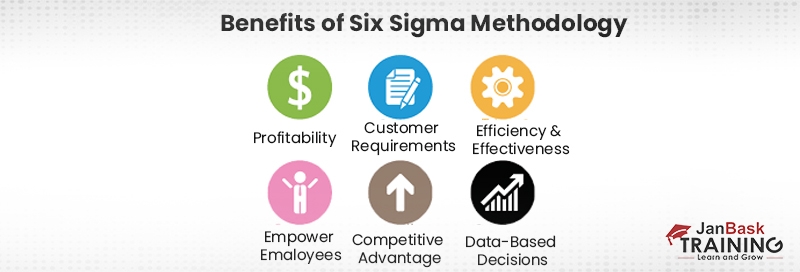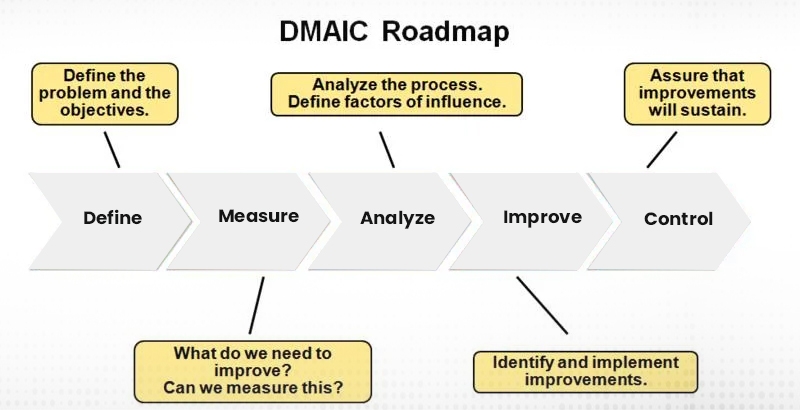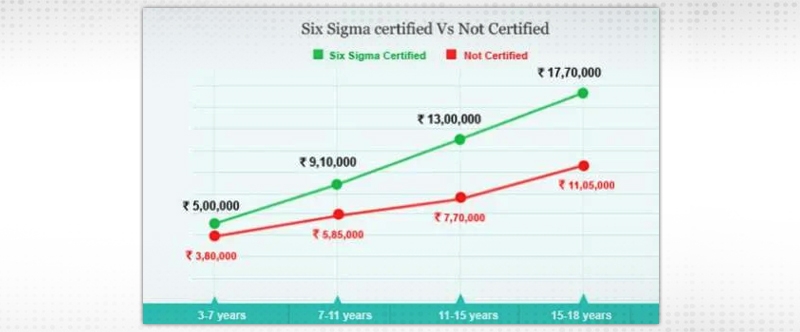Grab Deal : Flat 30% off on live classes + 2 free self-paced courses - SCHEDULE CALL
Grab Deal : Flat 30% off on live classes + 2 free self-paced courses - SCHEDULE CALL
Organizations equipped with vast amounts of services and products may sometimes find defects or problems in their products or services. In order to overcome these flaws before providing a service to other agencies, there are some platforms like six sigma, which help to minimize the defects to a great extent. In this blog post, we will discuss the six sigma, why six sigma, history, six sigma methods and the tools used by six sigma users. This six sigma for beginners mainly benefits the individual and professionals for the acquisition of knowledge about six sigma functions. Become successful in Six Sigma with our professional Six Sigma Certification Course and get certified.
Six Sigma is a popular discipline or process where you can focus on developing highly accurate or near-to-perfect products and services consistently. The aim of this process is to eliminate waste and deliver the best defects-free product as needed by customers. Based on the structured methodology followed by the process, will define the role of participants. Build job-ready skills for an in-demand career as a Business Analyst with globally recognized Business Analyst Courses.
This is data-driven, where we need more accurate data or information to initialize the processes. This is all about putting results on Financial Statements. The sigma is a statistical work that will define how a given process deviates by achieving perfection. The concept was discovered by Motorola in the 1980s due to an increase in product failures and defects. The thoughts of Bill Smith did magic but he soon died of a heart attack in Motorola Cafeteria in 1993. It is based on many quality management theories for the delivery of an error-free product at the client end.
Business Analyst Training & Certification

Six Sigma is a method of continuous improvement in customer satisfaction and profitability. Six Sigma's concept has a simple objective: to provide nearly perfect goods and services for business transformation in order to optimize customer satisfaction. See the infographic below to understand better-

Here are some of its features-
Six Sigma is an intrinsic part of business analysis. If you are looking to begin your career as a Business Analyst, you get everything you need to know about this job profile. Here is the complete Business Analyst Certification online course roadmap.
Six Sigma is dissected into three core elements. They are- The Customers, The Processes and The Employees.

Are you exploring challenging and exciting IT career opportunities? Do you wish to unleash your potential in analytical problem solving and building deep business acumen? Learn which are the trending Business Analyst skills in the job market.
The ultimate goal of any project or organization is to obtain the highest level of client satisfaction. Let's try to understand the various benefits or merits of Six sigma and why the company prefers a Six Sigma certified professional:

The increasing demand of business analyst has made it a more lucrative and suitable career option for many. See what are the roles and responsibilities of a Business Analyst from this blog.
Before we discuss the process approach followed by Six Sigma, let us have a quick look at how it works actually. Six Sigma is a quality management strategy where an environment is provided by management to support the Six Sigma program not as a standalone approach to satisfy someone's needs. This will emphasize DMAIC process methodology largely to solve any problem.

Further, the Employees or Six Sigma team are assigned projects that will directly impact the bottom line of an organization and maintain quality as per customers’ expectations. The Six Sigma concept is highly based on statistical techniques and also needs a little knowledge of statistical concepts for the best implementation of the program. Now, let us discuss in detail what is DMAIC and the list of DMAIC tools one by one.
For more credible and latest resources, enroll now in JanBask Training.
The process followed by Six Sigma is DMAIC whose meaning is Define, Measure, Analyze, Improve, and Control.
If you are planning to or have already decided to pursue a Business System Analyst career, that’s great. Before applying your candidature, know what a Business Analysts’s salary is based on experience level, companies, top global locations, you can expect or confidently should demand.
There is a particular set of tools for each phase of the Define, Measure, Analyze, Improve, and Control process.
Are you looking for a way to put your Business Analyst skills to test? Then look no further, for this is the BA quiz that will help you analyze your skills.
DFSS is a business process methodology that makes sure that every new product is designed as per customer needs and expectations and that products are already at six sigma levels or not. For this purpose, the organizations will be using a variety of tools like QFD or FMEA that would help in measuring the quality standards as defined by the customers. These tools can also be used to give an entirely new category of products to customers.
With the help of DFSS, you can always improve the current service lines or product standards. If you wanted to implement the DFSS then the business system should be sure of customer requirements at the first level. So, we can say that DFSS is simply used to design a new product or service as per customer expectations. Let us now see DFSS tools and how they are helpful for some organizations.
But, before moving directly to Business Analyst interview questions, let's see what are all possible kinds of questions that you have to face in your interview on Business Analytics at the intermediate and advanced levels.
QFD is a predefined standard for identifying or implementing customer requirements. This is a systematic approach to understanding customer needs and converting them into a set of designs. Also, the tool will make sure that customer needs and expectations can be met in less time and at manageable costs. The tool makes us realize how much the customer needs are important to us and what are the strengths and weaknesses of an organization.
As per QFD guidelines, you should design a set of questions to ask the customers and check what would happen if any product or service used by the customer fails. So, you have to understand the effect of failure and take the necessary steps to prevent damage during the event of failure. Now, let us move to our next tool i.e. FMEA.
For more trending questions on Six Sigma or Business Analysis, join JanBask’s popular e-learning community.
FMEA means Failure modes and effects analysis, this is a pre-emptive tool helping a system in the identification of the potential pitfalls at different levels of a business system. Also, it helps organizations in identifying and prioritizing the things during the event of failure and determining the effect of failure on customers as well. So, you will get a list of critical areas that are necessary to focus on to avoid failures. Keep in mind that FEMA could identify the critical areas but it cannot offer solutions to the identified problems. Let us further look at the categories of FEMA – these are DFMEA and PFMEA.
PFMEA means Process Failure modes and effects analysis and DFMEA means Design Failure modes and effects analysis. PFMEA is used when a new process is introduced to the system to uncover the hidden issues and how it can affect the system. At the same time, FMEA is used in the design phase to find out the failure modes and their effect on the system. It is generally performed before the product is sent to manufacturing and all design deficiency should be sorted out by the end of this process. Now let us see what FMEA Risk Priority Number RPN is.
With the FMEA RPN, you could quantify or assess the risks associated with the process or design of a system. The higher the RPN, the higher the priority received by the product or process. RPN is generally defined as the product of the severity of failures, the occurrence of failures, and the detectability of failure. With the help of these three values, it is always easy to manage a product and ensure the safety of most critical operations. The next important term is the FMEA table. With the help of FMEA, you can define the checklist of why defects occurred and how you can cure them. This table can be used for future references later.
After this section, we come to the end of our blog Six Sigma Tutorial Guide and cover all important topics that are necessary to learn for beginners. So, now you would be able to define what is Six Sigma, its benefits, key concepts, DMAIC methodology followed by the Six Sigma, DMAIC tools, and DFSS (Design for Six Sigma) etc. One more important term is Lean Six Sigma which would be covered in one of the other blogs in detail.
Thinking about what exemplary applicants do, whose resume makes it to the next level of the interview process? In this guide, we will help you walk around the entry level and senior Business Analyst resumes examples along with a step by step guide on how to write Business Analyst Resumes from scratch.
There are several career options for Six Sigma professionals as manufacturing engineers, compliance engineers and operational systems specialists. An aspirant can look into any of the job roles like Six Sigma Analyst, Six Sigma Black Belt, Senior Project Manager, Six Sigma Consultant and many more. In India, a Six Sigma Black Belt salary ranges from 7.2 lacs- 28 lacs with an average annual salary of 17.6 lacs p.a according to AmbitionBox. There are about 10k + job vacancies in Six Sigma on LinkedIn. See the graph to understand certified vs non-certified Six Sigma professionals.

Learn why Business Analysis is one of the most sought-after careers in 2022 from this blog.
In short, the adoption of six sigma not only stimulates the growth of the organization but also advances a person's career. Today's organizations are looking for six sigma certified professionals to enhance their quality of service. Professionals trained in the Six Sigma guidelines gain some skills and knowledge of useful tools for identifying areas for improvement. Earn a Six Sigma Certification Course to explore your potential growth in the relevant field.
Q1. What is the Six Sigma course objective?
Ans- The Six Sigma Certification Course has been specially designed to help the learners in mastering the various concepts of accelerating a project in every term. Learn Six Sigma techniques online and get to explore wider job opportunities with customized course content, hands-on assignments, and project-based learning environment. Our aim is to make your placement and certification easy. That is why we have incorporated concepts of all the major certifications in our curriculum.
Q2. What skills will I learn in this course?
Ans- When you have successfully endured and completed your extensive six weeks Six Sigma training, you will gain a major comprehension of:
Q3. Who should attend this course?
Ans- Anyone can sign up for the Six Sigma training and Certification course as it does not require any kind of pre-requisites, however, the course would be beneficial for-
Q4. How will I know which course to choose?
Ans- That is a very simple thing. You can visit our website and request a callback or you can avail of the live chat option on our website. Our student support executive will get in touch with you and clear all your doubts and answer your queries. The career counselor or executive will take a look at your profile, educational background, past experience, your interest area, and will suggest to you what courses you can take to rejuvenate or boost your career.
Q5. What type of study material will you provide?
Ans- We at JanBask Training understand the importance of complete knowledge and holistic development and that is why we provide you with a plethora of learning resources that are varied in their structures and forms. We provide you with e-books, informational blogs, videos, podcasts etc to supplement whatever you learn from the online training session. Not only this, but once the session is over, the recording is also delivered to you for anytime access.
Q6. What is the process for enrolling in a course?
Ans- It's a streamlined process. It is very easy; you just have to follow the given steps-
Q7. Will I get any assistance during the course?
Ans- Of course yes! We believe in supporting our learners to the best of our ability. You get all-time support not only during your training but even during your visits to our website and its pages. We are there with you at every step of your course journey. Not only this we are very easily approachable even when you have successfully cleared your course for any doubts, queries, or guidance.
Q8. How is online training better than offline curses?
Ans- Learning online now is as effective as offline training, especially with JanBask Training.
When you learn with us virtually for any course of your choice, you get a complete experience that is a replica of an offline classroom.
Our virtual classroom sessions of every course with great audio & video delivery, communicative teaching methods, and versatile study materials as MCQs, videos, eBooks, case studies are as effective as your offline classroom experiences.
All our classes are led by professionals who are working in giant companies like Google and in addition, to support the making of more industry-centric professionals, they have effective teaching methods that resonate with real-time classroom experiences. With their delivery, you won’t feel you are learning from a distance. blurs the lining of offline
Q9. How will you help me to be better in my next job?
Ans- JanBask Training’s courses are designed with an intention to deliver skills, knowledge & insights that are synonymous with the real job market demands.
Our industry expert trainers don’t feed you with just theory-based knowledge in order to achieve the certification exams, they expose you to real case scenarios, practical application of each skill, and the solicit techniques to help you dissolve faster in the job market.
They guide you on attributes that recruiters demand in a particular professional.
Q10. How can I enhance my professional self through these courses?
Ans- At JanBask Training, we don’t just prepare you for any certification exam, we prepare you for a satisfying & growing profession.
We aim to make you a substantial resource to any company or industry - by preaching you about the skills, based on real-time industry projects and scenarios. We don’t feed you with bookish knowledge, we feed you the resources that are practically important to pursue skills inside a profession.
Aakanksha Dixit is working as Research Analyst at JanBask Training. She has a flair for writing and believes in exploring new horizons in the IT industry to help the job seekers out there. She is a nature-lover, linguaphile, and a traveler.

Cyber Security

QA

Salesforce

Business Analyst

MS SQL Server

Data Science

DevOps

Hadoop

Python

Artificial Intelligence

Machine Learning

Tableau
Interviews
Erick Nelson
I want to know what the skills required for Six Sigma and this post helped me in understanding
JanbaskTraining
Hi, Thank you for reaching out to us with your query. Drop us your email id here and we will get back to you shortly!
Walter Carter
What a nice informative blog, a must-read for people who want to explore Six Sigma careers.
JanbaskTraining
Glad you found this useful! For more such insights on your favorite topics, do check out JanBask Blogs and keep learning with us!
Daxton Mitchell
Hey, is there any separate guide that you can help me to get prepared for these certification courses?
JanbaskTraining
Hi, Thank you for reaching out to us with your query. Drop us your email id here and we will get back to you shortly!
Martin Roberts
How to choose the best course among the numerous courses mentioned above?
JanbaskTraining
Glad you found this useful! For more such insights on your favorite topics, do check out JanBask Blogs and keep learning with us!
Damien Turner
Can anyone from a commerce background join the training? If yes, then whom to contact?
JanbaskTraining
Hi, Thank you for reaching out to us with your query. Drop us your email id here and we will get back to you shortly!
Dallas Phillips
I want to explore a few best courses for career growth, but confused about which one is better, I want to consult a Janbask consultant on this.
JanbaskTraining
Hi, Thank you for reaching out to us with your query. Drop us your email id here and we will get back to you shortly!